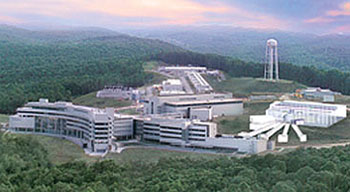OAK RIDGE, Tenn., Jan. 19, 2009 – The US Department of Energy (DoE) has given initial approval to plans for a second target station for the Spallation Neutron Source (SNS), expanding the world’s most powerful pulsed neutron scattering facility, located at the DoE’s Oak Ridge National Laboratory.
The Critical Decision Zero (CD-0) status is the first step in an approximately $1 billion construction project. The Second Target Station (STS) will be optimized for nanoscale and biological sciences, with an emphasis on novel materials for energy production, storage and use.
“The approval of CD-0 and the mission need statement for the STS reflects the department’s commitment to securing and expanding this nation’s leadership position in neutron science," said Harriet Kung, DoE associate director of science for basic energy sciences.

The DoE has given its initial approval for the Second Target Station at Spallation Neutron Source, depicted left. Image courtesy of the Oak Ridge National Laboratory.
With the addition of up to 24 instruments, the number of researchers that will have access to the SNS’ unique neutron scattering capability will eventually double from 2000 to 4000 annually.
“CD-0 approval is great news for materials research. The second target station will expand the Spallation Neutron Source’s capability for studying structure and dynamics on the nanoscale and provide for a growing community of users, maximizing the scientific investment in the SNS accelerator complex,” said Oak Ridge Director Thom Mason, who previously led the SNS project through most of its construction and start-up phases.
The new target station – the most intense source of its kind in the world – will generate long pulses of “cold neutrons,” which are cryogenically chilled to wavelengths that are more useful for molecular-scale analysis.
“The added suite of instruments will provide new research opportunities in technologically significant areas. With the SNS’s new capabilities for studying materials and processes at the micro- and nanoscale, researchers will have the tools to develop new materials for a broad range of applications, including advanced automotive battery technology, new steel alloys and pharmaceuticals,” said Ian Anderson, Oak Ridge associate laboratory director for neutron sciences.
Research at the first target station at SNS, which has 10 instruments either operating or in commissioning, already has provided new insight into the behavior of materials used for the efficient transmission of electricity and has facilitated the development of new methods of administering medicines.
As the home of the SNS and the recently upgraded High Flux Isotope Reactor, Oak Ridge is the world’s leading center for neutron science.
CD-0 is the first of five “critical decisions” that govern construction of DoE facilities and projects and is required before the development of a conceptual design study and submission of a budget request for project engineering and design efforts. The project completion is estimated for 2020.
Oak Ridge is managed by UT-Battelle for the Department of Energy. Funding for the STS is through the department’s Office of Science (Office of Basic Energy Sciences).
For more information, visit: www.energy.gov